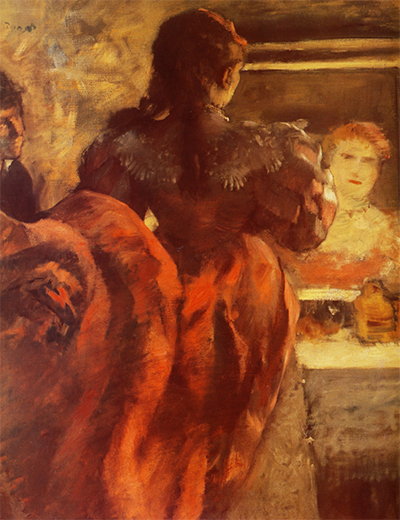The Parisian artist Edgar Degas was far beyond his time in terms of his artistic ability to capture authentic moments.
While the artist is most noted for his Impressionism style and one of the forefathers of the movement, he preferred to be regarded as a realist. Therefore, many of his pieces have a realist touch to them that significantly impact any viewer looking onto the artwork. The painting Dancer In Her Dressing Room illustrates a behind the scene moment of a performer getting ready to take the stage. While Edgar Degas is significantly know for his paintings showcasing ballerinas, some of his work paid tribute to other artists. This includes the paintings Miss La La At The Cirque Fernando, Singer In Green and At The Cafe Ambassadeurs.
The beautiful pastel piece illustrates yet another performer looking at herself either prior to going on stage, or upon her completion. Yet, based on the young man accompanying her to her left, it seems as if the painting is a moment in which the woman is preparing to take the stage. The woman is dressed in a large puffy dress that falls far below her feet. The back of the dress has a long veil that drags along the floor. This is evident as the man to the left is holding this large dress. The painting is filled with a warm orange shade that transitions into aspects of brown. The woman’s dress largely puffs at her shoulders outwards.
Layers of fabric fill the sleeves of the dress in a scale-like texture. The dress transitions into a tight corset along the woman's chest hugging the upper hand of her body. A soft white ruffle lines the collar of the dress in a silver snowflake design. Beneath the large orange-burgundy skirt, a layer of white chiffon fabric fills the skirt. As the woman's image is reflected in the painting, the viewer is able to witness the woman's chest largely exposed. The classic dresses of the era often exposed much of the performer's chest. The viewer is able to grab a glimpse of the performers face as she stares at the reflection. Rich ginger coloured hair covers the woman’s head delicately. Similarly, the viewer is able to witness her thin ginger eyebrows.
Degas created the work in an impressionist feel, so the characteristics of the woman’s face are not evident whatsoever. The viewer is barely able to see her eyes, apart from a small brown dot. In the reflection of the mirror, the woman’s small red lips are portrayed. Her pale skin is illuminated by a light source on the dresser that captures the woman’s energy. While the viewer is only able to witness a small portion of the man's face, it’s evident that he is looking into the woman in awe. It is unknown if he is a lover, or simply her helper. Nevertheless, the woman holds a powerful element to her as the admiration in the young man’s face is towards her.
Henri de Toulouse Lautrec was another artist related to the impressionist movement who produced scenes of life in Paris, at different levels of society. He lived much of his life in Montmartre, a small part of the city famous for helping the development of creative minds, often living on limited budgets. The likes of Picasso and Modigliani also impressed here. Toulouse-Lautrec's contributions included famous paintings such as Moulin Rouge: La Goulue, Ambassadeurs, Aristide Bruant and Jane Avril.
The remainder of the painting is covered in the same lively setting as the woman’s dress. It seems as if the colour scheme is based off of her burnt orange gown. White and brown brush strokes create the illusions of walls, table tops and mirrors. The artist does not care to use impeccable detail as it will only take away attention from the woman. It is her reflection looking at herself that is the key element of the whole piece. Degas had captured the performers final moments looking into herself before taking the stage, preparing her mind to perform.




